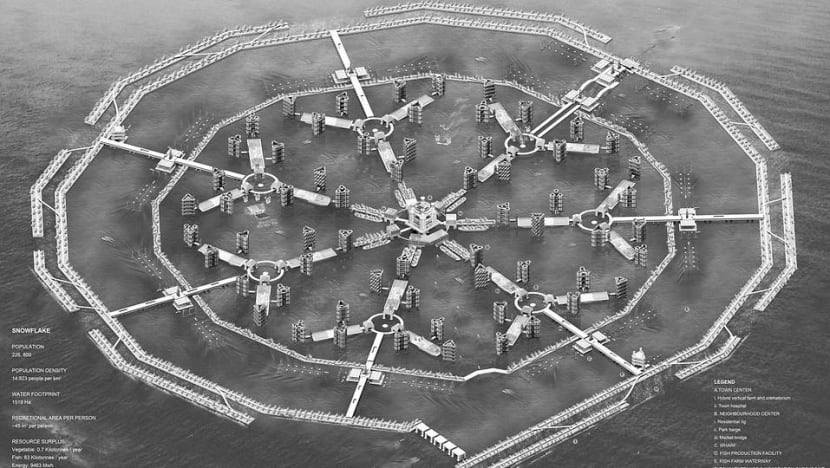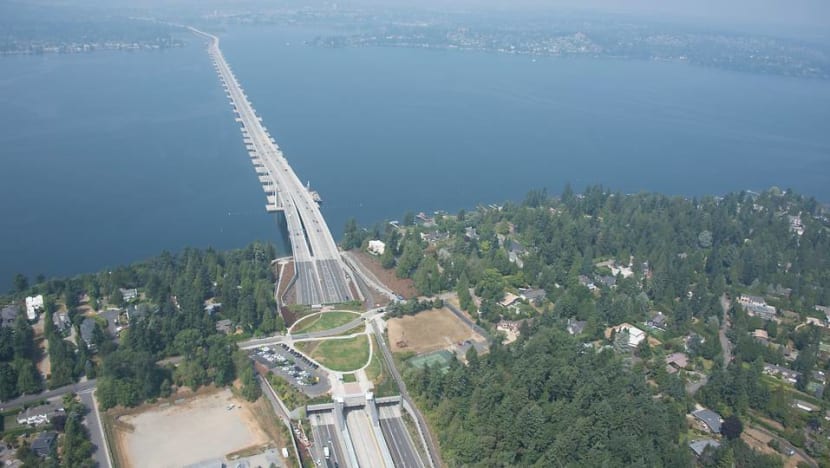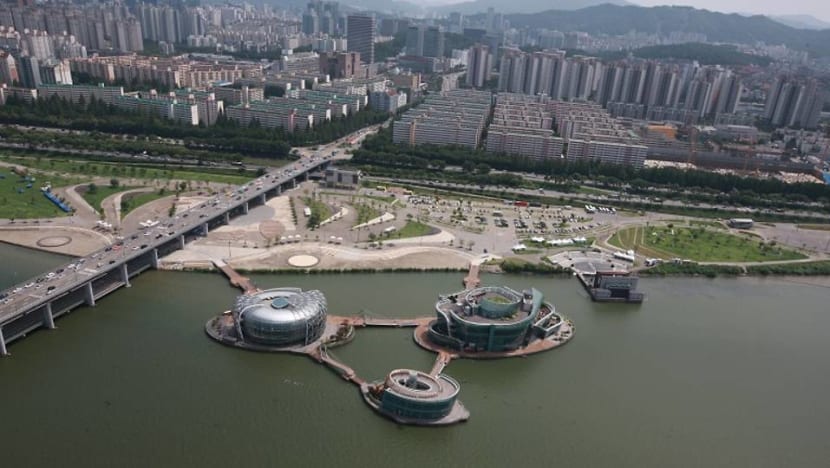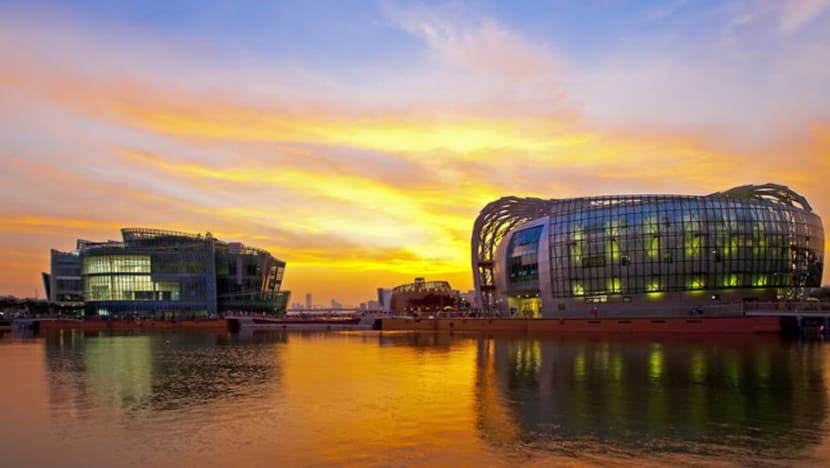Floating homes, parks, facilities - a reality in Singapore that's closer than you think?

An architectural mock-up of a floating settlement made up of seven flotillas. (Image: NUS Department of Architecture/Chris Wijatno, Davis Wong, Sakinah Halim, Roy Tay, Chen Qishen, Wang Yigeng, Bek Tai Keng)
SINGAPORE: Urban life on floating structures at sea is no longer something more likely to be found in science fiction, with experts estimating that large scale platforms could be a reality in less than a decade.
This comes as floating homes, storage facilities and even parks have been mooted as the answer to Singapore’s continued quest for land.
“We have been building higher and higher for the last 20 (to) 30 years. For going deeper, there is a limit to how far can you can go,” said Mr Lim Soon Heng, President of the Society of Floating Solutions (Singapore).
“With floating structures, you have such an enormous amount of space in the horizontal direction”.
FEEDING A HUNGER FOR LAND
Singapore is no stranger to creating additional land space on water. Since the 1960s, Singapore has reclaimed over 140 sq km of land, which is nearly a quarter of its original size.
It is now 724 sq km and growing, with an aim to pad itself up to 766 sq km by 2030.
However, land reclamation is becoming less viable as the country looks at the potential of deeper waters.
“It’s not like before when the waters were less than 10 metres deep. Now we’re talking about 25 or 30 metres, so the costs for reclaiming the land with sand is going to be enormous,” said Mr Lim.
WHY FLOATING STRUCTURES COULD BE A BETTER OPTION
On the other hand, floating solutions could offer a cost-efficient alternative.
“You can build a floating structure in a very short time, which means that you can monetise investment rapidly. Land reclamation takes several years before you can build anything on it,” said Professor Wang Chien Ming from The University of Queensland’s School of Civil Engineering.
According to Mr Lim’s estimates, building a float to support a bungalow would also cost as little as US$100 per sq m, while one for a skyscraper would cost US$1000 - 1500 per sq m.
He also noted that floating modules can be towed to wherever they are needed: “You put a structure on land like a building in Orchard Road, you're stuck with it in Orchard Road.”
WHAT FLOATING SOLUTIONS COULD LOOK LIKE
With its calm, sheltered waters and 193 km of coastline, Singapore is seen as an ideal place for these solutions, which are already being used elsewhere.
The world’s longest floating bridge in Washington State in the US stretches over 2.3 km.


Japan already has several floating airports, while South Korea’s Han River is home to Sebitseom, a cultural complex comprising three floating islands.


A floating dairy farm is also being built in the Netherlands.
For residential use, visionaries have conceptualised floating low-rise hexagonal floating settlements or one-kilometre tall green floats.
READ: In land-scarce Singapore, new spaces for homes on the sea and in the air, possibly
But with an eye on sustainability, a group from the National University of Singapore’s (NUS) architecture department has pictured megacities on decommissioned oil rigs.
The engineering marvels could be “appropriated” to become hospitals, theme parks, schools and even prisons, they say.

With almost 6.5 billion people living in cities by 2050, they suggest that greener cities are the way forward: The towering, self-sufficient settlements would come with wastewater treatment, energy-generating and food-growing systems.
“Once we are happily conceiving of floating settlements, the biggest fear is that these settlements could pollute the water as much as the land-based ones would,” said Assoc Prof Joseph Lim, who worked on the project with his masters’ students.
START WITH INDUSTRIAL USES FIRST: EXPERT
However, a more logical first foray for Singapore would be to target industrial purposes, which are less complex to manage, according to Mr Lim.
In fact, researchers at the National University of Singapore are already studying floating bridges, which can be relocated when needed.
Other ideas include storing oil on floating facilities, which would free up land and provide better access to ships.
Yet, it is easier said than done.
CHALLENGES AHEAD FOR FLOATING SOLUTIONS
The most immediate hurdle for implementation is regulation: Would floating solutions be considered a vessel or a building? Who would be in charge?
"It is neither here nor there. Let's create a new body that will take care of it and that will work with the Maritime Port Authority (MPA), PUB, Building and Construction Authority (BCA) and so on,” Prof Wang suggested.

There’s also the question of where to place these floating structures.
“After ensuring the safety of navigation for ships, providing for mooring spaces and bunkering, that leaves us with only very small ‘sterile’ sea spaces around little islands and parts of Singapore,” he said.
If MPA zoned certain areas as test beds, then proposals could come forth, Prof Wang added.
However, pointing out that Singapore has around 700 sq km of water space - almost the size of the island itself - Mr Lim said the issue of maritime space can be solved with a more “disciplined” way of mooring ships.
THE IMPORTANCE OF A TESTBED
This lack of “sterile” sea space for testing has been a pain point for advocates of floating structures, but it could change with the unveiling of Southeast Asia’s largest deepwater ocean basin.
The basin by the Technology Centre for Offshore and Marine, Singapore (TCOMS) can be used to test autonomous ships, marine robotics and large floating structures.
At its deepest point, it is 16 storeys or 50 m deep, which simulates depths of some 3,000 m.
Its panels will simulate actual oceanic conditions by generating multi-directional waves, instead of uni-directional ones that most existing basins do.
With its smart sensing and data analytics capabilities, it’s being hailed as a breakthrough for testing.
“The existing ocean basins like this are more than 20 years old and since then, a lot of developments have taken place in simulations,” said Professor Allan Magee, Director (Operations) at TCOMS.
“We're looking at developing a simulation that will give better understanding, because we want to know the behaviour of the real solution, not just the model.”
A FLOATING FUTURE IS “VERY CLOSE”
The development brings Singapore a step closer to a floating future, Prof Wang suggested.
“We are very close - closer than Singaporeans can imagine. We have all the jigsaw puzzles in place.”
Indeed, some observers agree that the technology is ready and capable, but a powerful barrier exists: Societal acceptance.
“The most important thing is whether or not people have a mental acceptance of living in the sea. I don't think it's a 100 per cent solution that will work for everybody,” said Associate Prof Lim.
Prof Wang is more optimistic: “If we can show people what it’s like, they will not be fearful. If you create (a floating attraction), they’ll go there for sure.”
In the meantime, Singapore is keeping its options open, as its urban planning authority says it will continue looking for opportunities above ground, underground, on land and in the sea.














